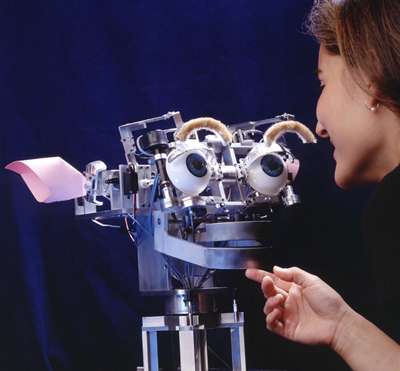Roboticist Cynthia Breazeal's first exposure to bots that could talk, joke, and emote like humans was Star Wars. But humanity has been preparing itself for what we now call "social robots" in books and movies for centuries, she told me over the phone.
"These robots weren't automatons, they're characters—collaborators, or even friends of their human counterparts," Breazeal said. "I was old enough at 10 to know that these robots didn't exist in the world and probably wouldn't in my lifetime. But as my life unfolded, the opportunity to actually try to create them came my way."
Advertisement
A chatty robot with the wherewithal to befriend a human is one of the easiest things to imagine, but turning that dream into a reality is one of the toughest engineering problems around—maybe ever. How do you make a machine that can exist autonomously in a complex environment, but also makes you want to cuddle?It's a question that Breazeal has been trying to answer since her earliest days at the Massachusetts Institute of Technology (MIT) in the 1990s, where she developed arguably the first social robot, Kismet. You might recognize Kismet. After all, it's pretty hard to forget; the talking mechanical head kind of looks like a Furby crossed with the Terminator.
Two decades later, Breazeal now leads the Personal Robots Group at the MIT Media Lab, which pushes the boundaries of what's possible at the intersection of robotics, design, and human psychology.Notably, the robots that Breazeal has created so far aren't very human-looking. They're more like pets, or little mechanical buddies. This might seem counter-intuitive if your mission is to create a robot that can collaborate with humans, but the way Breazeal tells it, it makes perfect sense."It's not about creating robots that look and act human—there's plenty of people in the world," she said. "It's because robots are so different from us that makes them fascinating. They can complement us and make enhance our lives. It's the possibility of working with something that's not human where all the potential is."
Advertisement
"Frankly, machines will never be human, so why put them against a yardstick that they will always fail at?"Outside of academia, Breazeal also trying to bring a social robot to market with Jibo, a little domestic robot with movements designed by Disney animators. But the project, first unveiled in 2014, has been beset by setback after technical setback, and is tentatively set for a 2017 release.It's not a great position for what some may just see as a fancy smarthome device not unlike the wildly successful AI-in-a-speaker Amazon Echo. Recent issues for Jibo included network latency, but the company maintains that in-home tests have shown that the bond between people and their little robots is real."I look back at early Steve Jobs talks where he shows a picture of the Apple I next to the iPad and you realize what an amazing trajectory the technology has been on to transform from this manila box to a sleek device that we now recognize as a tablet computer," Breazeal said."When these robots get out there, they're like the Apple I," she continued. "They may look like an iPad thanks to the influence on design that companies like Apple have had in the field, but they're the first instances of what they'll end up being as technology improves…It's the very beginning."Get six of our favorite Motherboard stories every day by signing up for our newsletter .

